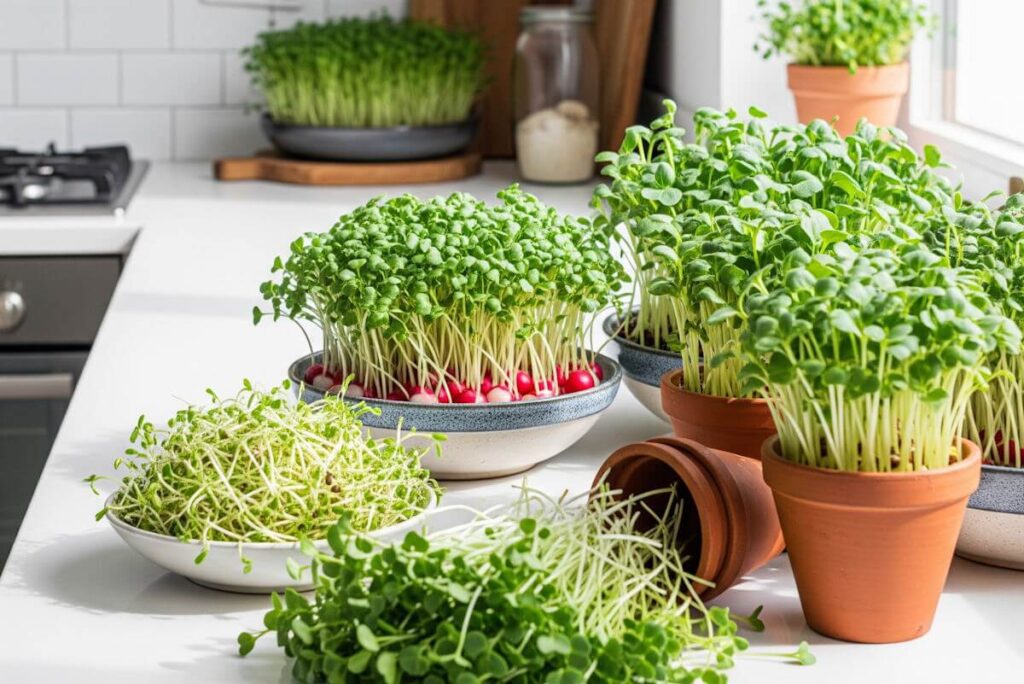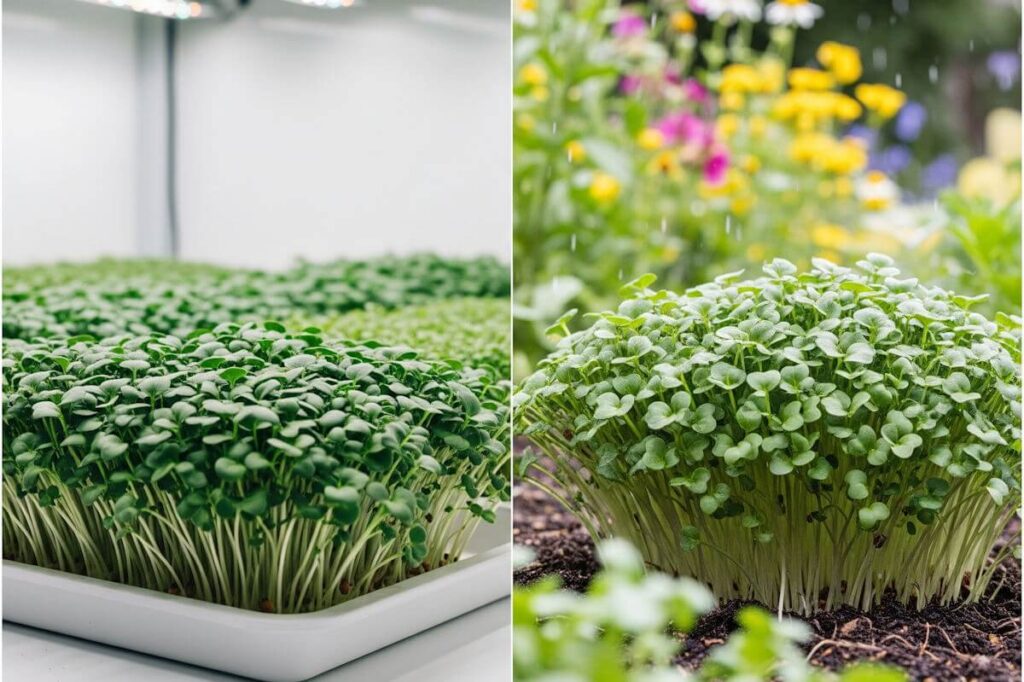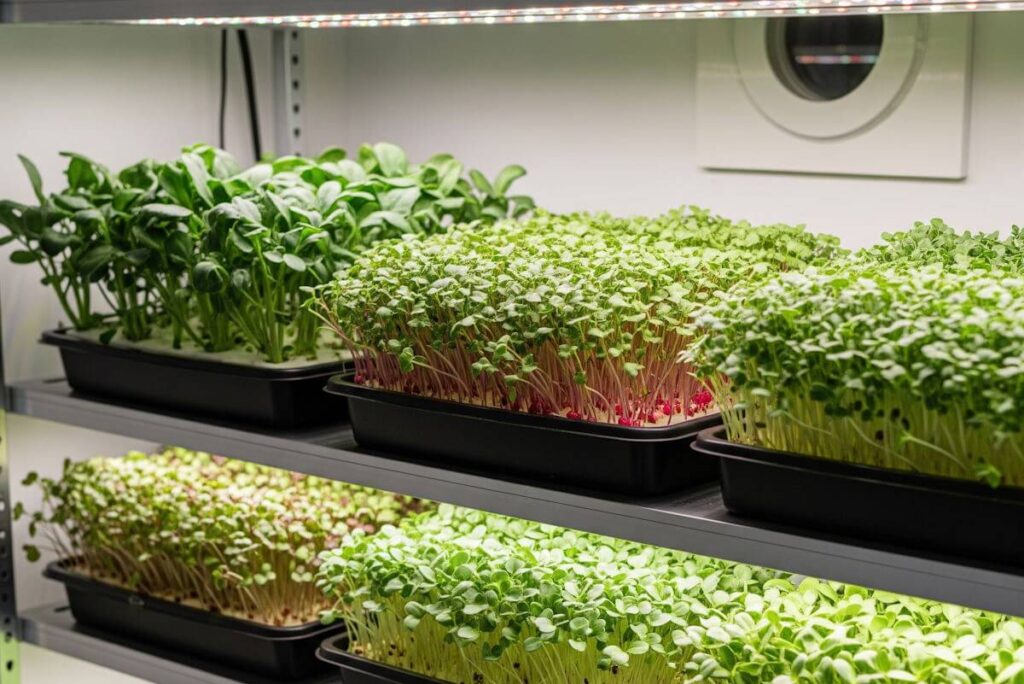Microgreens are young, edible plants that are harvested shortly after the first leaves, or cotyledons, have developed. These nutrient-packed greens have gained considerable attention in recent years due to their intense flavors, vibrant colors, and impressive health benefits. While they may be small in size, microgreens pack a powerful nutritional punch, often containing higher concentrations of vitamins, minerals, and antioxidants than their mature counterparts.
The growth process for microgreens is relatively straightforward and does not require vast amounts of land or resources. Typically, microgreens are cultivated in soil or hydroponically in containers, providing an ideal environment for seedlings to thrive. They can be easily grown indoors or outdoors, with just a few essentials—adequate light, moisture, and temperature regulation. Within a short period of 7 to 21 days after sowing the seeds, they can be harvested, allowing for a rapid turnover and fresh produce that is always available.
Research has demonstrated that microgreens are abundant in nutrients, including vitamins C, E, and K, as well as essential minerals like calcium and magnesium. Their rich phytonutrient content contributes to various health benefits, such as enhanced immune function, improved digestion, and increased anti-inflammatory effects. Additionally, the diverse varieties of microgreens—ranging from arugula and basil to radish and beet greens—further enrich the dietary options available to consumers, appealing to a wide audience interested in health and wellness.
As more individuals seek sustainable and nutritious food options, microgreens have emerged as a superfood that not only delivers exceptional flavor but also supports overall health. This introduction underscores their rising popularity, making microgreens a trend worth exploring for both culinary enthusiasts and health-conscious consumers alike.
Nutritional Powerhouse
Microgreens have gained significant recognition as a nutritional powerhouse, enriched with an impressive array of vitamins, minerals, and antioxidants that contribute to overall health. These young plants, harvested at the seedling stage, typically contain concentrated levels of essential nutrients relative to their mature counterparts. Research indicates that microgreens often contain up to 40 times more nutrients than fully-grown vegetables, making them a superior choice for enhancing dietary intake.
One of the standout features of microgreens is their high vitamin content, particularly vitamins C, E, K, and several of the B vitamins. For instance, microgreens such as radish and beet greens are remarkably rich in vitamin C, a powerful antioxidant that supports immune function and skin health. Additionally, microgreens are excellent sources of vitamin K, which is crucial for bone health and proper blood clotting.
Minerals also play a significant role in the nutritional profile of microgreens. These young plants are abundant in minerals such as calcium, magnesium, and potassium, which are essential for various bodily functions, including muscle contraction, heart health, and maintaining optimal hydration levels. The concentrated nature of these nutrients means that even small servings of microgreens can have a substantial impact on daily nutrient intake.
Furthermore, the antioxidant content in microgreens is noteworthy. Antioxidants protect the body from oxidative stress and reduce the risk of chronic diseases. Varieties like broccoli microgreens have been studied for their high levels of sulforaphane, a compound with potential anti-cancer properties.
In essence, incorporating microgreens into one’s diet can offer numerous health benefits, making them a valuable addition to meals and snacks. Their nutritional density not only enhances regular dishes but also encourages healthier eating habits among consumers looking for superfood options.
Versatility in Culinary Applications
Microgreens have emerged as a versatile ingredient in contemporary cuisine, gaining recognition for their remarkable ability to enhance both flavor and presentation. Available in various species, such as basil, radish, and beet, these tiny greens can effortlessly integrate into myriad dishes, providing culinary professionals and home cooks alike with an array of possibilities.
One of the most popular applications of microgreens is in salads. Their delicate textures and vibrant colors not only add visual interest but also infuse the dish with nuanced flavors. For example, peppery arugula microgreens can elevate a simple green salad, while sweet pea shoots can add a touch of sweetness. Additionally, they can be mixed with other vegetables or grains, creating a refreshing medley that appeals to diverse palates.
Beyond salads, microgreens lend themselves well to smoothies. Blending in microgreens, such as spinach or kale varieties, can enhance the nutritional profile without compromising taste. They often provide a boost of vitamins while blending smoothly into the mixture, making them an appealing choice for health-conscious consumers.
Garnishing dishes with microgreens is another method to elevate culinary presentations. Their vibrant hues and intricate shapes can transform an ordinary plate into a visually stunning masterpiece, increasing the overall dining experience. Microgreens can be used as a finishing touch on soups, appetizers, and entrees, adding a touch of color and enhancing the dish’s overall flavor.
Moreover, microgreens are not limited to traditional settings; they can also be incorporated into wraps and sandwiches. Their compact size makes them an excellent filling that contributes crunch and freshness without overwhelming other flavors. This adaptability highlights their role as a dynamic ingredient, allowing chefs and food enthusiasts to continuously experiment with new and exciting culinary creations.
Health Benefits of Consuming Microgreens
Microgreens, the young seedlings of edible vegetables and herbs, have gained recognition as a highly nutritious superfood. A growing body of research highlights their significant health benefits, making them an appealing choice for health-conscious consumers. One of the most notable advantages of microgreens is their ability to enhance immune function. A study published in the journal Nutrition Research revealed that microgreens, particularly those from the Brassica family like broccoli and cabbage, are rich in vitamins C and E, which play a crucial role in bolstering immune defenses.
Moreover, microgreens are known for their digestive benefits. These young plants generally contain enzymes and fiber that promote healthy digestion. They can act as natural detoxifiers, helping to eliminate toxins and support a healthy gut microbiome. As noted by various nutritionists, incorporating microgreens into meals can aid not only in digestion but also in nutrient absorption, maximizing the health benefits of the overall diet.
Another compelling aspect of microgreens is their potential cancer-fighting properties. Research has indicated that certain microgreens possess high levels of antioxidants, which combat oxidative stress and may lower the risk of some cancer types. Specifically, studies have shown that the phenolic compounds found in microgreens like radish and beet exhibit anti-cancer effects, making them a protective food choice for consumers. Experts advocate for a varied diet that includes these potent microgreens to harness their phytochemical benefits fully.
In summary, the health benefits of consuming microgreens, such as enhanced immune function, improved digestion, and potential cancer-fighting capabilities, underscore their status as a nutritional powerhouse. As scientific evidence continues to emerge about the advantages of including microgreens in daily nutrition, it is evident that these small plants pack a significant health punch.
Sustainability and Environmental Impact
Microgreens are increasingly recognized not only for their nutritional benefits but also for their sustainability advantages, making them an appealing choice for eco-conscious consumers. One of the most compelling aspects of microgreens is their low resource requirements. These small, young plants can be cultivated using significantly less water, soil, and energy compared to traditional crops, which often require extensive resources to grow and harvest. For instance, studies have shown that the water usage for microgreens is often 90% less than that of mature plants, positioning them as a resource-efficient agricultural solution.
Moreover, microgreens thrive in urban settings and can be grown indoors or in vertical gardens, enabling individuals and businesses to produce food locally. This urban cultivation reduces the need for long-distance transportation, contributing to a lower carbon footprint. As the trend towards urbanization continues, the ability to grow microgreens in limited spaces meets the demand for fresh and nutritious produce while minimizing environmental impact. Container gardens, hydroponics, and indoor farms are emerging as effective ways to integrate microgreens into city life, fostering a connection between consumers and their food sources.
Furthermore, the cultivation of microgreens often aligns with organic farming practices. Many growers prioritize the use of non-GMO seeds and avoid synthetic fertilizers and pesticides, leading to healthier ecosystems and improved soil quality. This approach not only protects the environment but also appeals to consumers who value sustainable and organic food options. By integrating microgreens into their diets, consumers can make environmentally friendly choices without sacrificing flavor or nutrition.
The combination of low resource requirements, urban adaptability, and environmentally friendly cultivation methods highlights why microgreens are an important superfood that aligns with sustainable living. As consumer preferences shift towards more sustainable food sources, the demand for microgreens is expected to continue growing, emphasizing their pivotal role in modern agriculture.
Growing Microgreens at Home
Microgreens are not only a nutritional powerhouse but also remarkably easy to grow at home. Embarking on the journey of cultivating these tiny greens can provide a rewarding experience while enriching one’s diet. To start your microgreen gardening venture, there are a few essential supplies needed.
First, choose a suitable container. Shallow trays or seedling flats work well, allowing for proper drainage and adequate growth space. It is recommended to ensure that the containers are clean to prevent any contamination. Next, opt for a high-quality, organic potting mix or a specialized growing medium designed for microgreens. These mediums facilitate optimal drainage and nutrient retention, fostering healthy plant development.
Once you have your equipment ready, it’s time to pick the right seeds. Many varieties of microgreens offer unique flavors and nutritional profiles, such as arugula, radish, basil, and sunflower. When selecting seeds, it’s wise to purchase those specifically labeled as suitable for microgreens to ensure quality and germination success. Be sure also to inspect the seeds for certifications, confirming that they are free from pesticides and contaminants.
To sow the seeds, evenly distribute them across the growing medium and cover them lightly with a thin layer of soil. Water gently to avoid displacing the seeds and place the trays in an area with bright, indirect sunlight. Alternatively, if natural light is limited, consider using grow lights to provide sufficient illumination. Keeping the growing environment consistently moist, but not soggy, is crucial during the germination phase.
After approximately 7 to 14 days, your microgreens will be ready for harvest. By snipping them just above the soil line, you can enjoy fresh, homegrown microgreens that significantly enhance your meals. This home gardening activity not only satisfies the desire for fresh organic produce but also encourages a deeper connection with the superfood trend that microgreens represent.
Market Trends and Consumer Demand
The recent resurgence in consumer interest towards healthy eating has significantly influenced market trends, particularly in the realm of fresh produce. During and after the pandemic, many individuals have become increasingly aware of the importance of nutrition and wellness. This heightened focus has driven a specific demand for healthy food options, with a strong preference for locally sourced and fresh ingredients. As a result, microgreens have emerged as a superfood that aligns perfectly with these evolving consumer preferences.
Microgreens, which are young vegetable greens harvested just after the first true leaves develop, are not only packed with flavor but also rich in nutrients. Recent studies have demonstrated that they can contain up to 40 times the concentration of vitamins and minerals found in their mature counterparts. The growing awareness of these health benefits has made microgreens particularly appealing to health-conscious consumers who are keen on enhancing their diets with nutrient-rich foods.
Moreover, the trend towards sustainability and local food systems plays a significant role in the increasing popularity of microgreens. Consumers are now more inclined to support local farmers and businesses. Growing microgreens can often be done in small spaces, making them accessible not only to commercial producers but also to home gardeners. This accessibility meets the demand for fresh, local produce, further solidifying microgreens’ place in the health food market.
As a result of these factors, the microgreens market is witnessing unprecedented growth. Retailers and food service establishments are becoming aware of this trend and have begun to adapt their offerings to include these nutrient-dense greens. By catering to the growing consumer demand for healthy, local, and fresh produce, businesses can capitalize on the burgeoning market for microgreens, providing exactly what customers are seeking during these transformative times.
Microgreens and Smoothies: A Perfect Pair
In recent years, smoothies have emerged as a popular health trend, prized for their convenience and nutritional benefits. The addition of microgreens—a diverse and nutrient-dense category of young, edible plants—can significantly enhance the health profile of these beverages. With their concentrated flavor and high levels of vitamins, minerals, and antioxidants, microgreens offer an excellent way to supercharge smoothies while introducing a new layer of taste.
To incorporate microgreens into smoothies, consider starting with a base of leafy greens such as spinach or kale. Then, blend in a generous handful of microgreens, such as arugula, broccoli, or sunflower shoots. These tiny plants not only enrich the nutrient density of your smoothie but also provide unique flavors. For instance, arugula imparts a peppery kick, while sunflower microgreens lend a nutty sweetness.
For a refreshing recipe, try a Green Power Smoothie. Blend together one banana, a cup of almond milk, a cup of spinach, and half a cup of broccoli microgreens. The result is a creamy drink that provides essential vitamins, assisted by the nutritious profile of the microgreens. Another delicious option is a Tropical Microgreen Smoothie, which combines a cup of pineapple, a cup of coconut water, and a handful of pea shoots. This combination offers a refreshing taste while ensuring a high intake of vitamin C and other vital nutrients.
Microgreens can also be used creatively in smoothies by employing them as a garnish or incorporating them into smoothie bowls. By blending them into a creamy yogurt base topped with fresh fruit, granola, and an artistic sprinkle of microgreens, you can create an appealing and nutrient-rich dish. This versatility ensures that microgreens can be seamlessly integrated into various smoothie recipes, attracting health-conscious customers eager to enhance their wellness journey.
Conclusion: The Future of Microgreens
Microgreens have undoubtedly carved a significant niche in the health food market, emerging as a superfood that appeals to an increasingly health-conscious consumer base. The myriad benefits they offer, including high nutrient density, versatility in culinary applications, and ease of cultivation, have contributed to their rising popularity. Rich in vitamins, minerals, and antioxidants, microgreens not only enhance the nutritional profile of meals but also elevate the visual appeal of various dishes, making them an attractive option for both home cooks and professional chefs. Their compact size and potent flavors allow consumers to incorporate these greens into their diet effortlessly, catering to diverse tastes and dietary preferences.
As we look ahead, the future of microgreens appears bright, driven by innovations in agriculture and changing consumer trends. Advances in agro-technology, such as hydroponics and vertical farming, are likely to streamline the cultivation process, thereby increasing the availability and affordability of these nutrient-packed greens. These methods can also support sustainability, reducing the environmental footprint associated with traditional agriculture. Moreover, consumer interest in local, organic produce is fostering a growing market for farm-to-table practices, which often include fresh microgreens.
It is also anticipated that the microgreens market will see the emergence of new varieties, broadening the choices available to consumers. Novel flavor profiles and unique textures will not only satisfy existing customers but also attract a wider audience, including those seeking gourmet experiences. Additionally, enhanced marketing strategies and educational campaigns can further promote awareness of the health benefits associated with microgreens, reinforcing their status as a superfood. In conclusion, with evolving agricultural practices and a commitment to meeting consumer needs, microgreens are set to thrive as a staple in the diets of the future, fulfilling the cravings of today’s health-conscious individuals.




